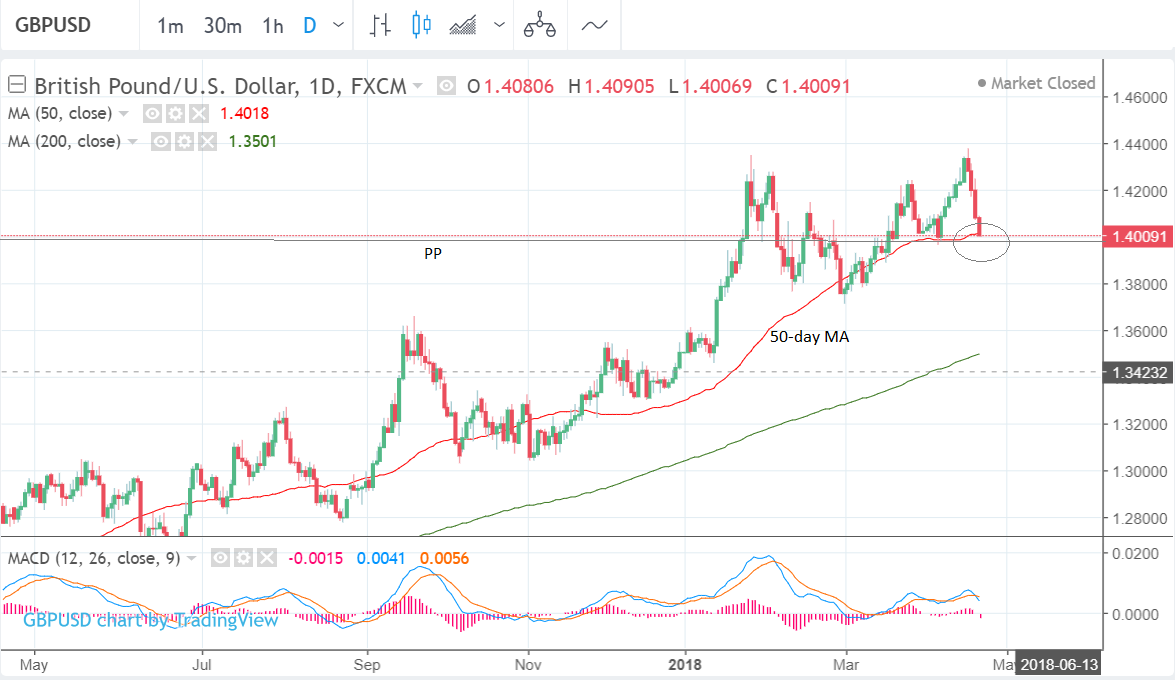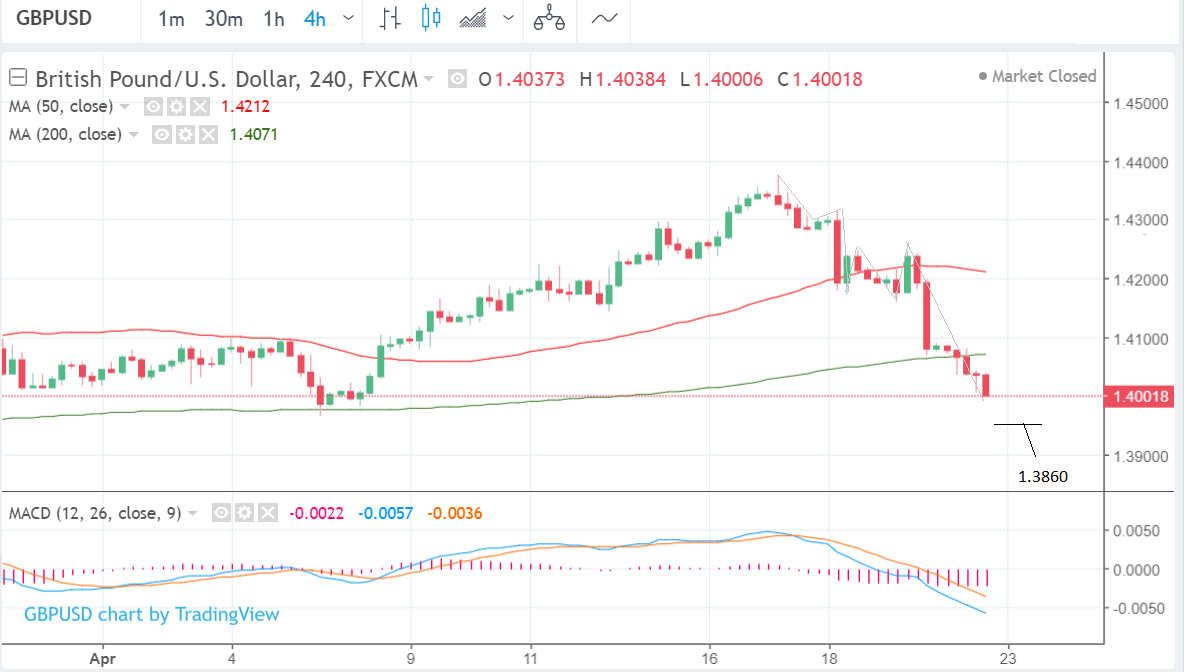Pound-to-Dollar Rate Forecast For the Week Ahead: Watching a Key Support Level
- GBP/USD has sold off steeply to the significant 1.40 level
- The main release for the Pound in the coming week is Q1 GDP on Friday
- The Dollar's main release is also Q1 GDP out on Friday

© DragonImages, Adobe Stock
GBP/USD finds itself at the psychologically pivotal 1.40 level as the new trading week commences.
The Pound-to-Dollar rate witnessed a decline over the course fo the previous week amidst fears that economic growth is stalling which in turn prompted the governor of the Bank of England (BOE) to cast doubt on the prospect of an interest rate rise taking place in May.
In the week ahead these issues may once again come to the fore as the first big data release of 2018 - Q1 GDP - is published. If it is lower-than-expected, the idea that the UK economy has lost momentum may gain currency and Sterling could weaken further.
Yet despite the bad news, the exchange rate remains above the 1.40 level - if only just - and has just found support at the 50-day moving average (MA) situated at 1.4018 (see chart below).
A purely technical analysis of the pair suggests the 50-day MA may put a floor under the exchange rate and limit further downside.
Large moving averages are particularly difficult to overcome as they are the locations of increased supply or demand due to more trading activity because they are popular indicators amongst investors.
We could see recent selling pressures subside in the coming week if this support level holds as buyers are attracted to a freshly discounted Pound.
The exchange rate would have to break clearly below the 50-day for confirmation of more downside, which would require a break below 1.3950 with the next target then at 1.3860.
Get up to 5% more foreign exchange by using a specialist provider to get closer to the real market rate and avoid the gaping spreads charged by your bank when providing currency. Learn more here.
Data and Events to Watch for the US Dollar
For the Dollar the week ahead is bookended by important data, with survey data for the Manufacturing and Services sectors (PMIs) out on Monday and Q1 GDP out on Friday.
PMI is short for Purchasing Manager Index, and is a score calculated from the responses of pivotal managers within a sample of organisations within a given sector. PMIs are viewed as useful early indicators of broader economic trends; a score above 50 is indicative of expansion, and below of contraction, in the sector.
Both the US Manufacturing and Services PMIs for April are out at 14.45 GMT on Monday, April 23. Manufacturing is forecast to decline to 55.2 from 55.6 in March, but Services is forecast to rise to 54.3 from 54.0 in the previous month.
A higher PMI is seen as bullish for the buck.
The other major release for the Dollar is the preliminary release of Q1 GDP, out on Friday, April 27 at 13.30.
Expectations are for growth to rise by 2.0% quarter-on-quarter (qoq) - on an annualised basis (ie over the last 12 months or year) - compared to 2.9% in Q4.
These general expectations are seen as an over-optimistic by Canadian Investment Bank TD Securities, who expect a slower pace of growth.
"We expect the advance estimate to confirm another disappointing Q1 near an on-trend pace of 1.6%. The main source of weakness is consumer spending (1.1%) but the trade will also be a drag," says TD Securities.
Nordea Bank's Andreas Steno Larsen, in contrast, is more bullish, forecasting 2.9% growth in 2018 as a whole, which would seem to suggest a not too low result in Q1 for there not to be a lot of catching up to do in the later Qs, however, Larsen also cautions against getting too focused on Q1 figures, which are "always weak" anyway, "so don't get too worried about the health of the US economy."
News and Data to Watch for the Pound
The main release for the Pound in the week ahead is the first release of GDP growth data for the first quarter of 2018, which is out at 9.30 GMT on Friday, April 27.
Expectations are for growth to slow slightly to 0.3% quarter-on-quarter (qoq) compared to 0.4% in Q4 and to remain unchanged at 1.4% compared to the year before (yoy).
This is no doubt due to the bad weather in Q1, but given growing doubts about the UK's economy in general the market may be expecting a lower result, which would further lower the probability of the BOE raising interest rates in May.
From being 96% certain the BOE would hike interest rates two weeks ago, the market is now only 50% sure - a lower GDP reading would reduce that even further. Generally higher interest rates equal a stronger currency and vice-versa as higher rates attract inflows from foreign investors drawn by the promise of higher returns.
Some analysts are even more pessimistic about Q1 growth.
"We are penciling in a slowing in the growth pace from +0.4% qoq in Q4 2017 to +0.2% in Q1. Furthermore, if anything, risks look to be to the downside of a +0.2% print," says Ryan Djajasaputra of Investec.
Although Djajasaputra puts it down almost entirely to bad weather rather than anything else, and thus a temporary negative.
"We suspect that Q2 GDP will not look quite as soft, especially with the household cash squeeze slowly turning around," adds the analyst.
Apart from GDP data, there are no other top-tier releases for the Pound in the coming week, but GfK Consumer Confidence is expected to continue showing a negative -7 reading in April when it is released on Friday at 00.01.
There are also three surveys from the Consortium of British Industry (CBI), the Business Optimism Index and the Industrial Trends Orders at 11.00 on Tuesday, followed by the Distributive Trades survey on Thursday at 11.00, which is forecast to show a rise to 5 from -8.
In addition, Public Sector Borrowing figures for March are out on Tuesday at 9.30.
Get up to 5% more foreign exchange by using a specialist provider to get closer to the real market rate and avoid the gaping spreads charged by your bank when providing currency. Learn more here.












